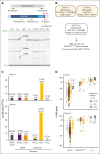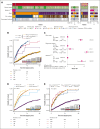IGLV3-21R110 mutation has prognostic value in patients with treatment-naive chronic lymphocytic leukemia
- PMID: 37505099
- PMCID: PMC10726246
- DOI: 10.1182/bloodadvances.2023010132
IGLV3-21R110 mutation has prognostic value in patients with treatment-naive chronic lymphocytic leukemia
Conflict of interest statement
The current affiliation for T.B. is Hospital Universitario 12 de Octubre, Madrid, Spain.
Figures




Comment in
-
Time to include IGLV3-21R110 status in CLL prognostication?Blood Adv. 2023 Dec 12;7(23):7382-7383. doi: 10.1182/bloodadvances.2023011243. Blood Adv. 2023. PMID: 38085552 Free PMC article. No abstract available.
References
-
- Hallek M, Cheson BD, Catovsky D, et al. iwCLL guidelines for diagnosis, indications for treatment, response assessment, and supportive management of CLL. Blood. 2018;131(25):2745–2760. - PubMed
-
- Eichhorst B, Robak T, Montserrat E, et al. Chronic lymphocytic leukaemia: ESMO Clinical Practice Guidelines for diagnosis, treatment and follow-up. Ann Oncol. 2021;32(1):23–33. - PubMed
-
- Nadeu F, Diaz-Navarro A, Delgado J, Puente XS, Campo E. Genomic and epigenomic alterations in chronic lymphocytic leukemia. Annu Rev Pathol. 2020;15(1):149–177. - PubMed

